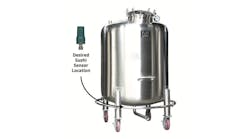Last months ISA Expo in Houston clearly showed how much attention wireless technology is attracting. Almost two-thirds of exhibitors displayed some wireless device, according to ISA. And many attendees definitely seemed interested in wireless technology although not necessarily for now.
Wireless devices still are relatively rare at most chemical plants because a number of issues are hampering acceptance. Some potential users worry about a lack of standards (see Lets cut through barbed wireless), while security concerns give others pause. Progress is being made on both fronts. Another concern centers on the powering of the devices.
Wireless doesnt necessarily mean without wires. Probably at 80% or more of locations at which wireless devices might be installed, noted one expert at the show, some source of power usually is readily available. Hooking up to such a source can boost reliability, ease maintenance and cut costs, while still avoiding the need for expensive cabling to control systems.
However, many people seem most interested in devices untethered by any wires. And, here, the use of batteries can be an issue.
Battery technology continues to improve. Claims of battery life of up to 10 years arent unheard of now although, of course, actual life depends upon the frequency at which data are collected and transmitted and environmental conditions. The cost of replacement batteries, which sometimes can run into the hundreds of dollars, coupled with the tab for having maintenance staff do the swaps also undoubtedly bother some potential users.
I put this to one guru on wireless at the show. The way wireless technology is advancing, he says, battery life may not be an issue in some cases because users may want to install an improved device well before they would have to change the battery.
However, the reliability and life of batteries clearly remains a nagging issue at many chemical plants, especially when it comes to installing wireless devices for critical services.
So, it wasnt surprising to hear more talk at the show about doing away with batteries by using so-called scavenged or harvested power, i.e., power generated in situ. And, its not just talk.
A variety of wireless devices sporting solar panels were on display. But, of course, the sun can do only so much at many plants.
What captured my attention was a booth featuring a different source for harvesting power vibration. After all, most sites dont lack for equipment like pumps and motors that generate some vibration.
A small firm called Perpetuum was running its newly commercialized PMG17 micro-generator that is aimed specifically at wireless applications. This ingenuous device can provide enough power to allow a wireless transmitter to send up to 6 kbytes of data, e.g., for condition monitoring, every few minutes or smaller amounts of data, such as temperature readings, several times a second, claims the Southampton, U.K.-based company, which was spun off in 2004 from the University of Southampton.
The 53-mm dia. × 45-mm high, 400-g unit contains a magnet-and-coil arrangement that converts kinetic energy of vibration, typically from machinery driven by AC synchronous motors, into electricity to charge a capacitor. This capacitor provides power even when the vibration source isnt operating.
A previous version has proven itself in field trials with a major oil firm, a U.K. water company and the U.S. Navy, says Perpetuum. The new model works with levels of vibration 35% lower than previously possible, it adds. The unit requires no maintenance and will outlast the electronics that it powers, the company claims.
If such micro-generators live up to their promise, vibration harvesting has the potential to truly shake up the wireless market.

